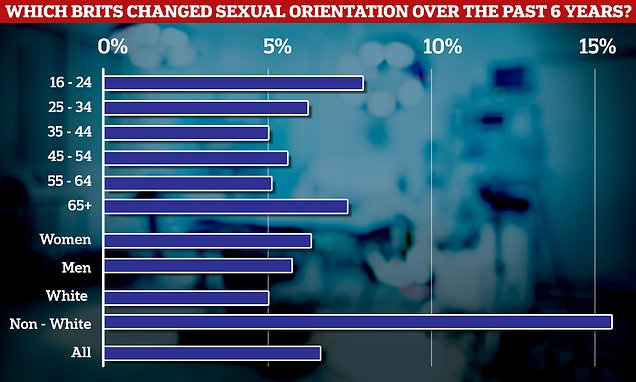Nearly 7% of Brits have changed sexual orientation in last 6 years
Sexually ‘fluid’ Britain: Report claims nearly 7% of population have changed their orientation in last six years – and 65+ are one of the biggest switchers
- Data based on surveys of 23,000 Brits tracking sexual orientation over 6 years
- Read more: Side effect warning over antidepressants that can ‘destroy sex lives’
Around one in 15 Brits have changed their sexual orientation in the past six years, according to a new report.
And over-65s, particularly women, are one of the groups most likely to switch up their sexuality, researchers found.
Lancaster University authors claimed the data — from an analysis involving almost 23,000 people — upturns the assumption that sexual ‘fluidity’ is largely confined to Gen Z and millennials.
Across all age groups, women, non-white individuals, and the less educated were more likely to change their orientation.
This could be from heterosexual to non-sexual, or the other way round.

A study led by Lancaster University found that one in 15 Brits (about 7 per cent) changed sexual orientation over the six years, based on data from 23,000 people though rates are particularly high among young people, the over 65s, and women in general
The academics also included a participant changing their ‘prefer not to say’ answer to one disclosing their sexuality, and vice-versa, as one of these sexual shifts.
This research is based on data from Brits who were quizzed once between 2011 and 2013 and again between 2017 and 2019.
Participants were asked on both occasions what their sexual identity was.
Answers included: heterosexual, gay or lesbian, bisexual, other, or prefer not to say.
Younger people, those aged 16-24, had the highest rate of fluidity, with 7.9 per cent changing over the course of the study.
Read more: Side effect warning over powerful antidepressants taken by millions: SSRIs like sertraline can ‘destroy sex lives’ even years AFTER patients stop taking them – prompting one leading psychiatrist to say: ‘Don’t go anywhere near them’

Sertraline was recently thrust into the spotlight by singer Lewis Capaldi who said he struggled to get an erection while on the libido-dampening medication
However, the over-65s weren’t far behind (7.4 per cent).
These rates compared to an average of between 5 and 6.2 per cent across the other age groups.
Across the entire group, the rate was 6.6 per cent — the equivalent to roughly one in 15 people in the UK.
The reasons why people changed their sexual orientation weren’t recorded.
At the onset of the survey, the vast majority of participants, 94.2 per cent, reported being heterosexual, 1.3 per cent gay or lesbian, 1.1 per cent bisexual, 0.8 per cent other, and 2.6 per cent stating they prefer not to say.
Despite there being an overall 6.6 per cent shift in sexual orientation among participants the actual breakdown of sexuality by type remained broadly the same six years later.
Put another way, the rate of people became heterosexual over the course of the study was broadly equal to those that ceased identifying as heterosexual.
Lead author Professor Yang Hu, an expert in global sociology, said the rate in older people in particular was driven by a portion ditching ‘prefer not to say’ as an answer.
He added: ‘The relatively high mobility rate among older people is largely driven by their heightened likelihood of moving into a heterosexual identity and forgoing an unwillingness to disclose their sexual identity.’
‘Our research establishes the scale and patterns of sexual identity mobility in the UK.
‘It does not explore the complex reasons for the mobility.
‘But our analysis does show changes in individuals’ sexual identification are closely associated with changes in their partnership status and partner’s sex.’
Professor Nicole Denier, an expert in sociology from University of Alberta and co-author of the study, told the Guardian finding that sexual fluidity didn’t stabilise as people got older was particularly interesting.
‘That assumption has given rise to much research focusing on adolescence as a critical stage of sexual identity development,’ she said.
‘But our findings suggest that changes in sexual identity represent an equally worthy research topic among the elderly and indeed across the full lifespan.’
Other findings in the survey included that women were significantly more likely to change sexual orientation than men.
A total of 6.3 per cent of women changed their sexual identity over the course of the study, compared to only 5.7 per cent of men.
Sexual fluidity was also just over three times more likely in non-white participants (15.5 per cent) in survey compared to people from a white background (5 per cent).
Publishing their findings in the journal Demography, the authors said why sexual fluidity appeared to be higher in some groups compared to others is unclear.
But Professor Hu added that when it come men and women, the former might be under greater societal pressure to not be honest about their sexual identity.
‘Existing theories suggest that rigid norms around “masculinity” may mean that men may be less flexible and fluid in their sexual identity expressions,’ he said.
Professor Hu added that their research had real world implications for policy makers wishing to support sexual minorities.
He said as their research showed sexual identity can change over time, the population such measures are designed to support should also show adaptability.
‘Our findings show that the sexual minority population is not static, and identities and partnership practices may change over the course of people’s lives,’ he said.
‘As the composition of the sexual minority population may shift, policymakers must be attuned to the changing characteristics and needs of the population’.
Source: Read Full Article
